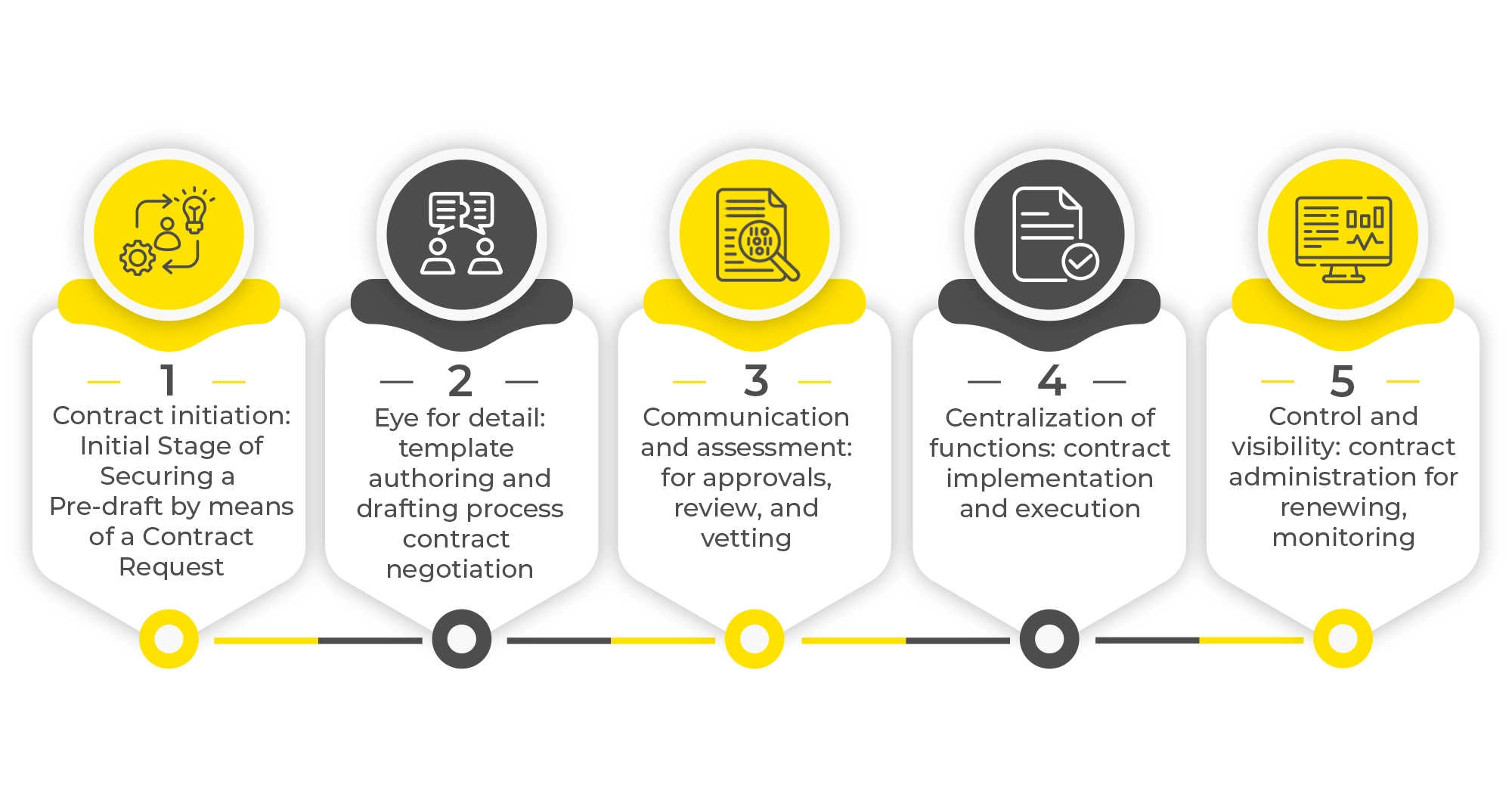Contract management is the quintessential function for any business organization that involves collaboration with multi-functional teams, external vendors, and customers. Legal departments have a significant role in ensuring that the contract management processes align with the regulatory compliances and the company's internal process as well as business interests. Even with the best of the teams, contractual processes may still continue to plague most legal departments, amidst other workflow challenges that include collaborating efficiently with teams, ad-hoc approaches to manage workflows, and streamlining all the individual functions into one.
5 Key Stages To Streamline Your Contract Management Workflows

This is where an automated contract lifecycle management system can be of immense benefit. The contract lifecycle management (CLM) system ensures, among other things, prompt generation of contracts, timely approvals, and implementation of contracts that help improve the performance of contracts and allow teams to have timely access and control. Some of the key stages involved in the process of contract management for teams working on legal contracts are:

Stage 1 - Contract initiation: Initial stage of securing a pre-draft by means of a contract request.
Request for a contract- this step marks the beginning of the contract workflow process. This refers to a request for a contract, sent by any of the several means available under the CLM system. This involves:
- Standardized contracts reduce and can help the mitigation of risks from a long-term perspective. According to Forbes, evolving business relationships require companies to drive contract standardization, which can be ensured with the help of a comprehensive clause and template library. This provides consistency, significantly reducing the risk inherent in contractual relationships.
- For every contract, standard templates serve as a good starting point for companies to streamline the contract lifecycle.
- Online editing of contracts for collaborative discussion, edit / addition / removal of clauses. The cloud-enabled CLM platform is advantageous as it allows teams to collaborate with external stakeholders, clients/suppliers; hence all the end-users know what is going on with the contract workflow processes.
- Speed and quick turnaround time -with a centralized repository that can improve efficiency
Focus on the right tool will help businesses determine the contract's terms and reduce overall risk exposure.
Stage 2 - Eye for detail: Template authoring and drafting process contract negotiation
Some contracts may be straightforward, and others may be as complicated as they can get. In other words, each contract or agreement is unique in its way. With teams working in tandem to secure contracts, standardized contract types will typically be the go-to for more reasons than one. That said, there will always be a need for customization of the templates to suit specific business or organization objectives and realities. This is where the contract negotiation phase becomes critical and is vital to the successful achievement of the targeted deliverables.
- Demand and securing initial contract draft based on the specific requirements of respective
- Framing contract templates, based on keyword search, and a clause library
- Before securing the initial draft, businesses must determine the company's interests, the regulatory compliances, and the performance of contracts of similar nature in the given scenario.
For every contract, standard templates serve as a good starting point for companies to streamline the contract lifecycle.

Stage 3 - Communication and assessment: For approvals, review, and vetting
Establishing an effective channel for the approval process is crucial at the point of assessment and evaluation, re-drafting, and review of contracts. This is a pivotal stage involving negotiation, redlining, and vetting.
- Initiative contract Approval, mark to specific approvers, clause, and deviation approvals from within the contract.
- Annotate comments on clauses.
- The approver can thus instantly approve, comment etc., speeding up the process. The online CLM systems, like RazorSign, also allow multiparty collaborative approvals as well. All of this is supported by an exhaustive audit trail.
Stage 4 - Centralization of functions: Contract implementation and execution
Contract execution, till date was a manual process of getting the wet signatures on the document. This process also caused inevitable delays, logistics issues and operational hassles. With e-signatures fast becoming an established practice today, execution of contracts can be done from any device, safely and securely that allows businesses to standardize business processes and improve overall customer experience. Thus, an e-signature integration enables an organization to gain:
- Time and cost savings
- Faster cycle -times and execution
- Reduced errors
- Greater security
Stage 5 - Control and visibility: contract administration for renewing, updating, monitoring or cancelling a contract
The penultimate stage involves contract renewals upon expiry, negotiations before approvals, and other vetting processes. In a legacy system, notifications and updates had to be tracked and traced manually, which often led to details falling between the cracks. In sharp contrast to the legacy systems, the CLM has features for timely and automated reminders that can significantly reduce the burden of managing contracts during the post-execution stage. This enables:
- Tracking expiry dates and renewals
- Tracking obligations under the contract
- Set reminders for the above
These five stages of contract automation systems, in other words, contract lifecycle management systems called CLM for short are what helps to streamline the entire contract process, taking the parties smoothly through contract creation, negotiation, approvals and execution – then taking over and assisting the contract management and administration phase of renewals updates etc. Thus, the net result is a set of streamlined operational processes that tend to give efficiency and productivity benefits over time.
Share on -